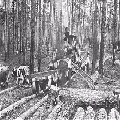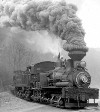Next Stop, The River!

With a boom crane in tow, they're
off to the river to unload. A few
"river beers" and its back to the
bunkhouse till 3:00AM when they
start their day.
|
Cheese!

These guys deserve more than just
a picture. Loggers throughout all
North America were a hearty bunch. |
|
Log Rail Track

Often it was necessary to use trees
for rails. The lighter weight Climax
with double flanged wheels were the
only efficient way to work.
|
Chained Log on skids

Nice photo of Oregon logging area.
Making a ramp of scrap logs to allow
easier pulling by the Donkey. |
|
Workin Overtime

Some logging camps utilized steam
generator lights for 24 hour use.
In 1889, Edison provided the first
steam powered electric light to the
logging industry.
|
Logging in Oregon

Check out the Guys standing in front of this Loader! |
|

|
Some photo's are of Logging in Timber, Oregon, Montana and Virginia. All have the flavor of ruff and tumble plaid shirted men, risking life and limb to bring much needed lumber to market. It's estimated that in the years from 1866 through 1923, the total tree's felled produced enough board feet of finished lumber to build 166,000 homes. |
|
The photo's here and a few hundred like them have helped me model an HO scale layout depicting logging in the 1860's. If you enjoy these, stop back once a month for for the next round of old photographs. |

|
|
Last Tree Standing

Often when loggers were through
logging an area, the crane support
(tree) that was used to "trolly"
the cut timber onto waiting log
buggy's, would be allowed
to remain standing. Usually the
only remaining tree around.
|
Donkey Loading Railcar

Yes the guy standing in this photo
is real...What scale?.... |
|
Switchback on 12% grade

I've incorporated this idea into the
Rush Run Layout. My lack of bench area
prompted the need to access elevated track.
This worked perfect. Try it!
|
|
|